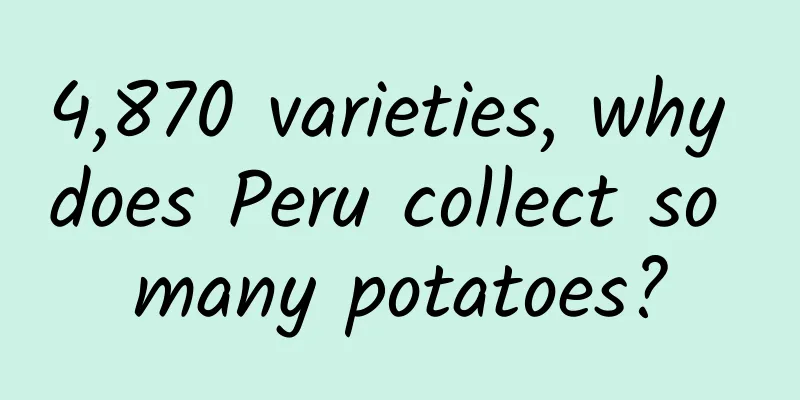4,870 varieties, why does Peru collect so many potatoes?

|
In two inconspicuous small buildings in the southern suburbs of Lima, the capital of Peru, there are some mysterious large rooms . The thick curtains in the room are drawn tightly, but the light inside is dazzling. The layout of the room looks like a warehouse, with densely packed shelves, but there are only rows of glass test tubes on the shelves - looking through the glass covered with water droplets, there are green plant seedlings inside. A strange "warehouse" that may look familiar to biology lovers | cipotato.org These rooms are indeed warehouses, but not just simple warehouses, but the potato germplasm resource bank of the International Potato Center (Centro Internacional de la Papa, CIP), which houses the world's most complete potato germplasm collection, with 4,870 different varieties of potato seedlings planted in test tubes filled with culture media, waiting for scientists and breeding experts around the world to write in and request them. International Potato Center Headquarters|machutravelperu.com Why store so many varieties of potatoes? With the progress of agricultural modernization, the diversity of crops has been decreasing . Not only are there fewer and fewer species being cultivated, but the varieties are also becoming more and more monotonous. In the past 100 years of the last century, the genetic diversity of crops has been lost by 75%. The loss of diversity is the price of maximizing efficiency . Farmers hope that the large agricultural machinery they bought at a high price will be used to deal with uniform crops - the same height, the same depth, sowing and picking at the same time. However, the single variety may also bring serious problems or even disasters. Modern potato harvester | AVR bv / Wikimedia commons The Great Irish Famine in the mid-19th century was, from one aspect, a disaster caused by a single crop variety. At that time, almost all Irish people planted a potato variety called "Irish Lumper". It was very good, and even in muddy and barren fields, it could produce quite a good harvest, and a small piece of land could feed a large family. But when faced with Phytophthora infestans from Mexico, this variety was defeated and had no ability to fight back. Potato tubers infected with late blight | Howard F. Schwartz / Colorado State University Then the potato blight swept through Ireland, bringing devastating famine and displacement. But we need to pay attention to one detail about this disaster: before arriving in Ireland, this strain had already attacked potato-producing areas in the United States and Europe. Potato late blight did cause some losses in the United States and continental Europe, but the damage was far less than that in Ireland . The reason for this is, on the one hand, of course, that these regions are not as dependent on potatoes, and on the other hand, the potato varieties grown in the United States and Europe are more diverse, and many of them have a certain resistance to Phytophthora infestans . The two main transmission routes of potato late blight, the red one is the one that caused the Irish famine | Kentaro Yoshida et al. / wiki commons Nearly two centuries later, late blight is still one of the most important diseases threatening potato production, but it is not as harmful as before. Today, we have more pesticides and field management methods to control this disease, and we can also directly address the root cause and breed disease-resistant strains . It's not just late blight. As one of the most important food crops for mankind, potatoes face far more than just one disease threat - large-scale planting gives them the opportunity to come into contact with various known and even unknown plant pathogens, and foreseeable climate change will also threaten potato production. We need not only disease-resistant and insect-resistant varieties, but also drought-resistant and flood-resistant varieties, as well as heat-resistant and cold-resistant varieties. Where do the genes of these resistant varieties come from? The first choice is, of course, from those known resistant strains ; secondly, many resistance genes are hidden in those traditional varieties that have not been studied, waiting for us to discover; thirdly, if it really doesn’t work, we can also turn to the closely related species of potatoes. Through the means of interspecific hybridization, we can "implant" the resistance genes into the crop strains we want. Different varieties of potato tubers | Michael Major / Global Crop Diversity Trust That’s why we need to protect the genetic diversity of potatoes as much as possible – so that we will have more means and possibilities to cope with disasters in the future. Why save potato seedlings? When we think of germplasm banks, the first thing that comes to mind is often piles of different seeds. Why do we choose living seedlings, which are more fragile and have higher maintenance costs, when preserving potato varieties? Staff need to regularly check the survival status of the seedlings | cipotato.org This starts with the way potatoes are propagated. In agricultural production, potatoes can be easily propagated through tubers and stably retain the characteristics of this variety. Therefore, potatoes can be regarded as a typical "clone crop" - the newborn juveniles and the mother plant have exactly the same genes, which are called a "clone group" and are sometimes even regarded as the same life form. There is no way to preserve cloned crops through seeds, because if you wait for them to bloom and bear fruit and reproduce them through seeds, many of their excellent traits may not be preserved. Living preservation is the only way to store cloned crops. The so-called "potato seeds" we grow are actually potato tubers | Doug Beckers / Wikimedia commons The storage time of tubers is limited. Filling small sterile test tubes with culture medium and letting the plants grow slowly inside is currently a relatively safe and effective strategy that takes up as little space as possible . In order to slow the growth of seedlings, the researchers also specifically lowered the storage temperature (6-8°C) and added sorbitol to the culture medium to impose a certain amount of osmotic stress on the seedlings. These measures successfully reduced the frequency of bottle changes from every 6-8 weeks to every 2 years. The harsh environment will make the seedlings look a little unhealthy and grow very slowly. But when needed, just take a small amount for tissue culture|cipotato.org The International Potato Center is also trying to use more cost-effective long-term storage methods, such as deep freezing with liquid nitrogen . In ultra-low temperature environments, samples can theoretically be safely stored for centuries without losing activity. However, deep-frozen samples cannot withstand repeated freezing and thawing , and the cost and risk of sampling are undoubtedly higher than that of live storage. The International Potato Center has specially optimized the process to combine live storage with deep-frozen storage, making full use of the advantages of both. Now, more and more potato varieties are left as backup in the ice storage, waiting to be revived when they are needed. Treating potato stem tip tissue with liquid nitrogen at -196 degrees Celsius to achieve long-term preservation of living tissue | cipotato.org Why Peru? More than 1 billion people in the world rely on potatoes as their staple food . The potato is grown from Greenland in the north to southern Chile in the south, up to 4,700 meters above sea level, covering almost all areas where humans can carry out agricultural production. However, if we trace back to the source of its growth and domestication, our eyes will eventually focus on the Andes Mountains in Peru and Bolivia in South America. The majestic Andes Mountains | Paolo Costa Baldi / Wikimedia commons The earliest artificial cultivation of potatoes can be traced back to about 8000 BC to 5000 BC. Through the analysis of genetic markers, all edible potato varieties originated from the area equivalent to today's southern Peru. Among the more than 4,000 known potato varieties, the vast majority come from the Andes , of which more than 3,000 varieties have been discovered and collected in Peru alone. Peru is well-deserved to be called the "home of potatoes". Different potato varieties collected from Peru | cipotato.org The International Potato Center's germplasm collection began with about 1,800 traditional potato varieties donated by the Peruvian National Potato Program . In the following 45 years, the number of varieties in the germplasm collection reached 17,347; but after extensive research, re-identification and deduplication of these samples, the number of varieties has been greatly reduced. Currently, the germplasm collection contains 4,870 cultivated potato varieties, including 4,467 traditional local varieties and 403 improved cultivars from 17 countries. The germplasm resources of the International Potato Center include not only potatoes and their related species, but also more than ten kinds of edible Andean roots and tubers, including sweet potatoes, wood potatoes, Jerusalem artichokes, and maca. The tubers of Tropaeolum tuberosum, eaten as a vegetable or as a staple food | Michael Hermann / Wikimedia commons Any organization can request these samples from the International Potato Center for research , breeding or educational purposes. As the world's largest potato-growing country, 25% of China's planting area is planted with potato varieties directly or indirectly cultivated by the International Potato Center. We face a future filled with uncertainty, but if we can harness the treasures buried beneath the Andes, and the diversity on which we depend , perhaps we can make the world healthier, more resilient, and more inclusive. Author: Old Cat Editor: Mai Mai This article comes from the Species Calendar, welcome to forward If you need to reprint, please contact [email protected] |
>>: Is AI invincible in fake human voice?
Recommend
In addition to the Northeast giant orange, are there any other "tigers" with outstanding combat capabilities?
The Year of the Tiger is here, and all kinds of p...
The way for Chinese people to go out to sea and see the world +1, China's first domestically-produced large cruise ship "Aida Magic City"!
Review expert: Zhu Guangsi, member of Beijing Sci...
The Economist: In January 2024, the rise of DeepSeek triggered a boom in China's AI industry, and the Hang Seng Technology Index rose by more than 40%.
The Economist published an article titled "T...
Let's prepare to pay tribute to the Xiaomi Empire
"Introduction": This is a long article....
The formula for creating popular educational short video content
As an account operator, I pray for the birth of a...
Is the cost of Taiyuan Express Mini Program investment high? Taiyuan Express Mini Program Investment Fees and Process
How much does it cost to recruit investors for Ta...
Dissecting Wanda e-commerce: How did it create O2O by spending 5 billion RMB and hundreds of millions of credit cards?
The bet between Wang Jianlin and Jack Ma has come...
Exclusive analysis of the secrets to increasing the amount of creative advertising material from 0 to 1!
1. The core logic of delivery As an agent, what s...
Nissan: Nissan's sales in China in January 2025 were 45,418 units, down 30% year-on-year
Recently, Nissan Motor Company announced its perf...
How much does it cost to invest in Anshan Sports Mini Program?
How much does it cost to attract investment in An...
Can you spend the New Year peacefully by developing a small program? You may be overthinking
Open Baidu Index to check the keywords of " ...
Changing the course of biological research: AI models unlock the code of life information
There are many research directions in the field o...
WeChat photo editing and beauty mini program function, how much does it cost to make a WeChat mini program for old photo restoration?
Nowadays, it is really difficult to distinguish t...
A guide to operations, upgrades and monster fighting for children aged 0-10!
According to the career development stages of ope...
Is bacon, a must-have during the Chinese New Year, really healthy?
Among the rich and diverse New Year goods, bacon ...









